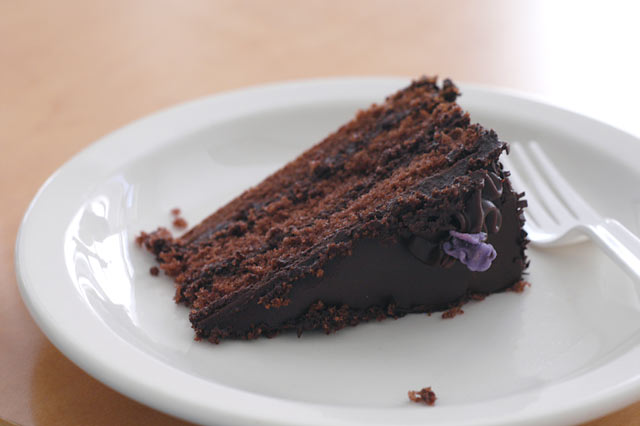Table of Contents > Recipe and Essay Mrs. Gustafson's Chocolate Cake
Cooking Time: PT25M
Cooking Method: bake
Category: dessert
Cuisine Type: American
Servings: 8-12 servings
Related: dbPedia entity
Ingredients:
- 1 1/2 C. sugar (use 1/2 C. in egg whites), 1 stick of butter (1/2 C.), Salt, 1 tsp. vanilla, 3 eggs-separated, 2 squares chocolate melted in 1/2 C. water and cooled, 1 tsp. soda in 2 1/4 C. cake flour- sift 5 times, 1 C. buttermilk or sour milk
Directions:
- Preheat oven to 350 degrees.
- Grease and flour two 9x2-inch round cake pans, tapping out excess flour; set aside.
- Lucille's tip Bake at 350 degrees for 25 mintues, or until toothpick inserted into middle comes out clean. Allow to cool for about 5 minutes on metal cooking racks, remove cakes from pan (facilitated by wax paper if using that method), and return cakes to cooking racks. Let cool completey. Fill and frost as desired, I recommend raspberry filling with cream cheese frosting.
- Bake at 350 degrees for 25 minutes, or until toothpick inserted into middle comes out clean. Allow to cool for about 5 minutes on metal cooking racks, remove cakes from pan (facilitated by wax paper if using that method), and return cakes to cooking racks. Let cool completely.
- Fill and frost as desired, I recommend raspberry filling with cream cheese frosting.

Table of Contents > Recipe and Essay Uptown Living During the Great Depression
Most summer days Lucille Mae Paddock-Balfour (at the time Campbell) could be found lying on her cot reading one of her two public library books for the week. She would lose herself in literature, escaping the sweltering summer heat on the porch of the family's one room cabin on Barker Creek, eight miles east of Anaconda. Lucille's father who was "never out of a job" worked fewer hours as a bookkeeper for the Anaconda Copper Company during the Great Depression. But as a result of being relatively secure financially the family was able to negotiate a long-term lease with the Forest Service and a permit to build a cabin.
The cabin was a rather simple structure. A single room, fourteen-by-twenty feet, made of unlined boards and two-by-fours. Lucille refers to the cabin as being "real uptown," having both running water pumped from a dam in the river, hot water "sometime if the fire had been burning," and electric lights in the form of six 6-volt lights powered by an auto battery.
A bit of ingenuity was required when trying to find solutions to the issues of cooking and refrigeration. The family home in Anaconda did not have an icebox; the family was used to daily shopping trips to Kelly Commercial. Lucille's mother would walk to Kelly Commercial to shop and then have the groceries delivered. A similar process would have been impossible at the cabin, requiring a process of refrigeration. Uncle Bud, who "could do anything," rigged up a sort of icebox, submerging a wooden barrel into the creek. This makeshift icebox would keep food chilled while holding treasures such as pop for the girls.
Cooking on the cabin's wood stove proved to be the most challenging. Without the luxury of a temperature gauge or regulator, cooking and especially baking was guesswork. Lucille remembers, "everyone overcooked [vegetables], except potatoes." Lucille also recalls her fondness, or lack thereof, for cauliflower, summing up her feeling for the vegetable in a single word, "mush." Canned soup and creamed vegetables became staples in the family's diet-- soup, due to its relative ease in procuring, cooking, and storing; creamed vegetables resulting from the trouble in regulating stove temperatures and her mother's seeming fondness for creaming "everything."
Solutions to baking were managed in more of less trial-and-error fashion. Small cakes called "try cakes" were baked to test the temperature of the oven, a treat for Lucille and her two sisters, Virginia and Avirl, before the actual cake was finished. Lucille's mother managed to "bake plenty of bread, cakes, and cookies in [the oven at the Barker Creek Cabin]." Such aromas would revive Lucille from her visit to far always lands. It was here at the cabin that Lucille first began her 'little black book' of recipes, a continual treasure and wealth of knowledge for the family. The tradition of writing all your favorite and most frequently used recipes down in your own recipe book is a tradition that has instinctively been continued by each of the women in my family. One of the most hotly contested issues is who has Great-Great-Grandma Campbell's recipe book.